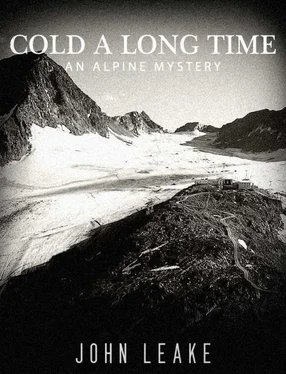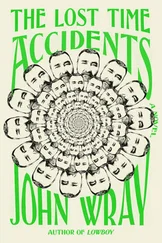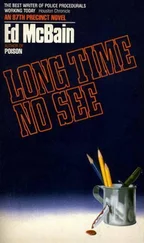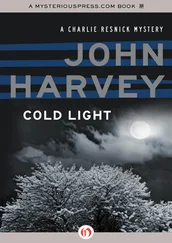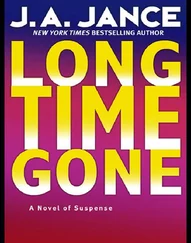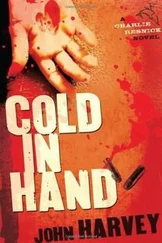As they would soon learn, the ski run was on a single glacier called the Schaufelferner, which was just one of five glaciers (none of which was actually called Stubai) that comprised the Stubai Glacier ski area. Looking up from the Schaufelferner’s base, the MacPhersons could clearly see its entire surface. About twenty searchers and two tracked vehicles were moving around on it, looking for Duncan’s body.
“Nothing could have happened to him here,” Bob said. “It’s tiny and the entire slope is groomed.” To be sure, there was a large, out-of-bounds area just east of the slope, but it was separated from the ski run by a walking path bordering the east boundary, and the path was lined with a row of stakes strung with a rope cordon. Even if Duncan had crashed through the path and into the out-of-bounds area, he would have ripped up these lines and stakes, leaving an obvious trace that he’d gone off-piste.
No one told them that about halfway to the top of the glacier, to the immediate left (facing uphill) of the tow-lift, was an area of crevasses that tended to open in August, and that a tourist had gone into one of them exactly one year before Duncan was last seen on the slope. Though Inspector Brecher had written a report on the accident, he mentioned nothing about it to the MacPhersons.
After surveying the ski slope, they walked behind the Eisgrat Station, which is built on a rock formation that rises above the glacier’s bottom end, or “snout.” Behind the building, a path descended to the valley. In theory, someone could have tripped and fallen on the path, but it was clearly visible from the gondola and regularly used by hikers. So, other than the small, controlled ski slope and the hiking path below it, there was nowhere to go.
It was conceivable that Duncan had decided to walk down and then taken a long, detour hike. He’d last been seen on the lift at 2:30 P.M. Assuming it was his last run, he could have been ready to hike down around 3:00. Sunset on August 9 was around 8:30, which would have left him with five solid hours of daylight. However, with no snow on the mountain below the glaciers, there was nothing to conceal his body in any area where he might have taken a fall.
They rode the gondola back down and returned to the hotel. Consul Ian Thomson had just arrived from the Canadian Embassy in Vienna. He was accompanied by District Gendarmerie Commander Franz Hofer, who was rigged out in what appeared to be a full dress uniform. Though aloof with Lynda and Bob, Hofer seemed very attentive to Thomson. The two men talked in German, with Thomson rarely pausing to translate for the MacPhersons. He did, however, invite them to join him and Hofer for an inspection of the ski slope. Back at the Eisgrat, they again looked up at the glacier. Thomson spoke with Hofer about it, but conveyed little of their conversation to the MacPhersons. What exactly did the gendarmerie commander tell the Canadian consul?
“I don’t know,” Bob explained to me twenty years later. “Lynda and I just stood there like two spare pricks in a whorehouse, with no idea what this pompous-looking guy was saying.”
That evening Inspector Brecher informed them that the search team had not found Duncan’s body. Before the men looked further, they wanted more specific information about his last known location. Brecher had also spoken with a Stubai Glacier employee who remembered that on or around August 9, he had seen a tall young man visiting a waterfall below the glacier. The run-off from the summer melt was strong, and over time the falls had created deep, eddying pools. It was conceivable that Duncan had fallen into a pool and drowned. According to Walter Hinterhoelzl, Duncan had mentioned his desire to walk down to the valley, but Walter had advised against it, as it would stress his knees, which were already weak from hockey injuries. Walter believed that he might have decided to hike up to the Eisgrat on August 10 and visited the falls on the way. A search team would, Brecher explained, inspect the falls in the morning.
Chapter 6: “I think you should get on with your lives.”
September 25 began with a trip to the Youth Hostel in Innsbruck, where they got a copy of Duncan’s registration for the night of August 8. Lynda then called Heinz Dorn at the Innsbruck Police and asked if his men had completed their search of hotel registrations. Dorn replied that Duncan had not spent the night at any licensed accommodation in Innsbruck during the month of August.
“Are you sure your officers checked all of them?” Lynda asked.
“Yes.”
“Including the Youth Hostel, a few blocks from your police station, where Duncan spent the night of August 8?” Dorn said he didn’t know what she was talking about. She explained, and then asked him to double-check to make sure that Duncan hadn’t also spent the night of August 9 or 10 in the city.
That evening the MacPhersons had a long talk by the fire with their hotel’s manager and receptionist. Bob had just bought a pictorial history of the Stubai Valley, and the book made him wonder about the history of the Stubai Glacier. The hotel manager, a woman named Angelika Ladner, and the receptionist, a girl named Gabi Frischmann, were both from the valley (they were cousins) and knew the story well.
The Stubai Glacier was built in the early seventies by a man named Heinrich Klier. Not only did he build the gondolas and lifts, he also extended Road 183 (the two-lane paved road running the length of the Stubai Valley) eight kilometers in order to provide car access to the ski area. Before he extended the road, no one had ventured into the narrow, southwest end of the valley except highland herdsmen and hikers. During the summer months the herdsmen had grazed their cattle on a highland meadow (Alm) which became the site of the two hotels, parking lots, and gondola station. Though most of the former pasture had been developed, it retained its old pastoral name—the Mutterbergalm.
Building the Stubai Glacier and its dedicated road had been an enormous, high-risk project, and most of the people in the valley had thought Doctor Klier (he held a doctorate in literature) crazy. No one—perhaps not even Klier himself—had imagined it would be such a success. For the year 1989, they were on track to have almost a million visitors.
The last stretch of 183 and the parking lots were the private property of the Stubai Glacier, whose personnel regulated traffic. On that note, Angelika said she’d spoken with the head of parking about Duncan’s car. He was, she explained, a very exact man, and he was certain the car had not been in the lot before September 1.
The next day, September 26, the MacPhersons drove to Innsbruck to hear the results of Inspector Klotz’s investigation. With Walter Hinterhoelzl as their interpreter, they had a long discussion, but Klotz’s overall message was simple: The gendarmerie had found no sign of Duncan after August 9. They were unable to trace his call to Ron Dixon in Vancouver, and therefore had no concrete reason to believe that Duncan had made the call after August 9. Klotz suggested they try to trace it in Canada.
As for Duncan’s car, Klotz concluded it must have sat in the gondola station parking lot since August 9. The gendarmerie had not noticed it because it didn’t patrol the lot, which was the private property of the Stubai Glacier. Everyone else who saw it must have assumed that its driver had gone for a long “hut tour,” as many visitors did in August.
It was conceivable that Duncan had gone on a hut tour after his snowboarding lesson. All over the Stubai Alps, huts were built during the late 19 thcentury by the German Alpine Association. Though the word “hut” conjures images of a crude structure, some of them are substantial buildings with comfortable room and board for hikers. With decent shoes and a few layers of clothing, one could set off from the Eisgrat Station and hike from hut to hut. It was a safe and easy way to enjoy the mountains, provided one stayed on the marked paths. Venturing off the trails could be very dangerous.
Читать дальше
